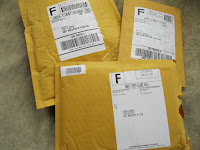Shy of four packets still on their way from Select Seeds, here is my farm. I wanted to share it at that magical point I think anyone who grows from seed can relate to. It is April. The ground is dug. The earth is weedless and waiting. The design on paper says every corner will be full. And here, literally, are the seeds of the dream. All is potential. All is perfection. It is manageable, spread out here on the sunny window seat in my warm living room on a snowy April morning: no weed can spoil, no rabbit chew, no drought destroy. For one shining morning, the pocket farm fits neatly in my pocket.
FEDCO has been my absolute favorite seed company (and supplier of books, growing supplies, trees and bulbs) for twenty-plus years. They are affordable. Their non-glossy catalog is extensive, rich in information, and a delight to read. (...And read, and re-read. In the tub, in the car, in bed at nights, FEDCO catalogs are my main source of winter entertainment and summer continuing education. Old dog-eared copies have begun to accumulate on my bookshelf as well.) They have a sense of humor. The seeds germinate, the trees settle in without a hiccup. From FEDCO come zinnias, sunflowers, edible nastirtium and marigold, colored and flavorful basil and fragrant additions like sweet peas and mignonette.
Johnny's Seeds is glossier, and knows how to attract market farmers. Their selection of cut flowers is hard to ignore, despite the high price of shipping a few packets. Fama Blue scabiosa (so much prettier than its name) and rocket snapdragons join the ranks.
Seed Savers Exchange is similarly glossy and expensive, but has become a greater interest as I make the transition from home gardener to market grower, but also as I begin to consider the value of saving seeds from my crops, not buying all of it in every year or two and trusting there will always be skilled and willing growers out there able to produce this pocketful of promise for me from one year to the next. In the simplest terms, of course, any open-pollinated (non-hybrid) seed can be saved if you have the staying power and skills of observation to see your plants through from seed to seed. Unfortunately, this most ancient of skills is becoming freighted by copyright laws, politics and corporate machinations. Seed saving is at the heart of many deep-rooted issues having to do with time, money, climate, and sense of land permanence and birthright. Meantime, the folks at SSE have helped foster my awareness of growing seed-to-seed. Plus they have the kind of sage used in smudging, plus artichokes for foliar and floral interest and Mexican Tarragon which did far better for me than the finicky French stuff, with gorgeous little flowers as an added bonus. Now I'm off to round up pots and get this garden started. Bloom!


No comments:
Post a Comment